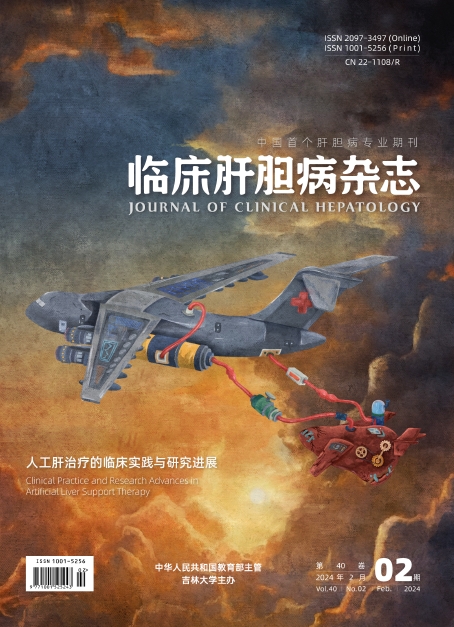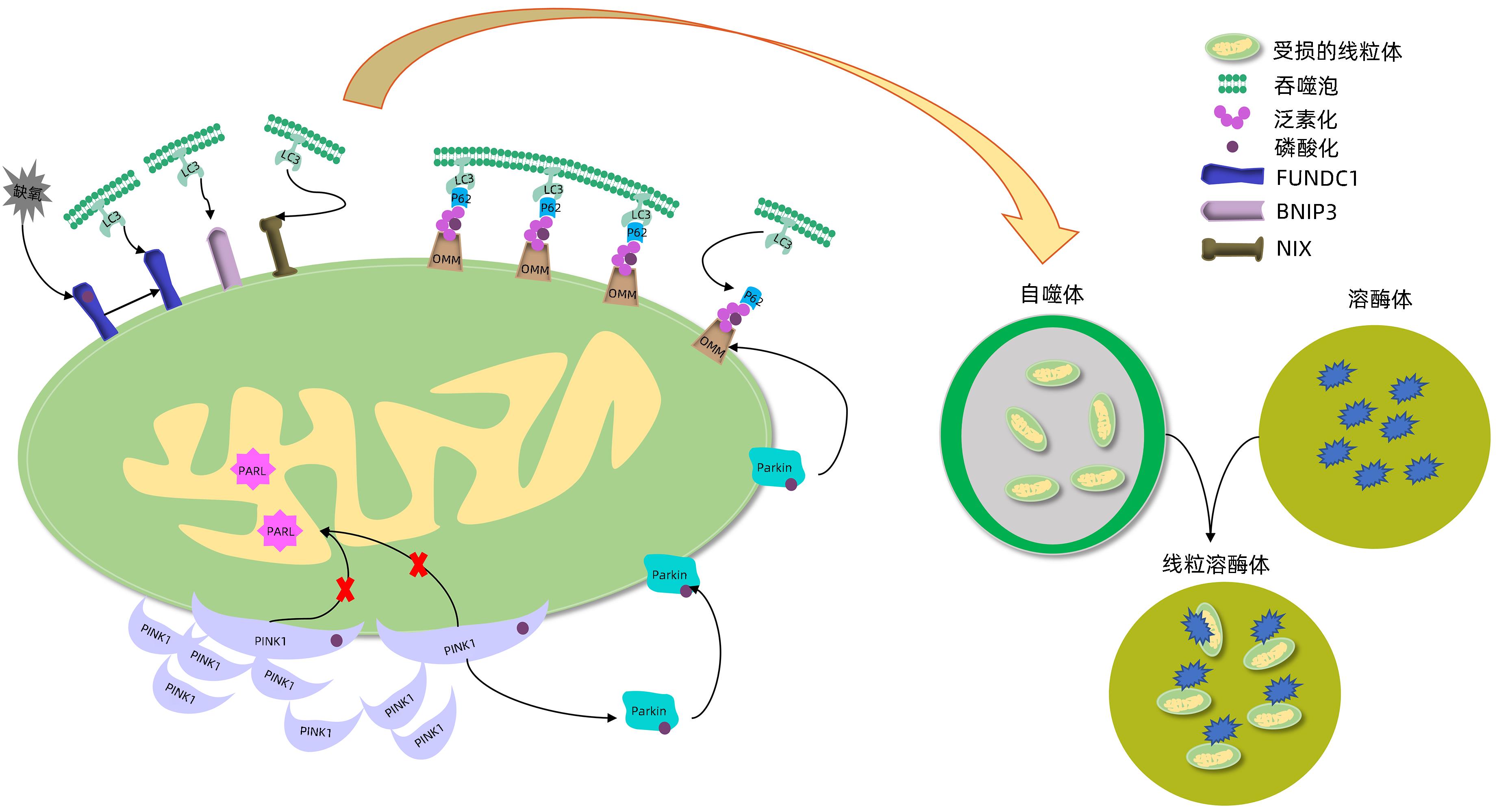| [1] |
QIAN H, CHAO XJ, WILLIAMS J, et al. Autophagy in liver diseases: A review[J]. Mol Aspects Med, 2021, 82: 100973. DOI: 10.1016/j.mam.2021.100973. |
| [2] |
GRATTAGLIANO I, RUSSMANN S, DIOGO C, et al. Mitochondria in chronic liver disease[J]. Curr Drug Targets, 2011, 12( 6): 879- 893. DOI: 10.2174/138945011795528877. |
| [3] |
|
| [4] |
GOIKOETXEA-USANDIZAGA N, SERRANO-MACIÁ M, DELGADO TC, et al. Mitochondrial bioenergetics boost macrophage activation, promoting liver regeneration in metabolically compromised animals[J]. Hepatology, 2022, 75( 3): 550- 566. DOI: 10.1002/hep.32149. |
| [5] |
QIU YN, WANG GH, ZHOU F, et al. PM2.5 induces liver fibrosis via triggering ROS-mediated mitophagy[J]. Ecotoxicol Environ Saf, 2019, 167: 178- 187. DOI: 10.1016/j.ecoenv.2018.08.050. |
| [6] |
KE PY. Mitophagy in the pathogenesis of liver diseases[J]. Cells, 2020, 9( 4): 831. DOI: 10.3390/cells9040831. |
| [7] |
GARZA-LOMBÓ C, PAPPA A, PANAYIOTIDIS MI, et al. Redox homeostasis, oxidative stress and mitophagy[J]. Mitochondrion, 2020, 51: 105- 117. DOI: 10.1016/j.mito.2020.01.002. |
| [8] |
SUN K, JING XZ, GUO JC, et al. Mitophagy in degenerative joint diseases[J]. Autophagy, 2021, 17( 9): 2082- 2092. DOI: 10.1080/15548627.2020.1822097. |
| [9] |
MA XW, MCKEEN T, ZHANG JH, et al. Role and mechanisms of mitophagy in liver diseases[J]. Cells, 2020, 9( 4): 837. DOI: 10.3390/cells9040837. |
| [10] |
KLIONSKY DJ, EMR SD. Autophagy as a regulated pathway of cellular degradation[J]. Science, 2000, 290( 5497): 1717- 1721. DOI: 10.1126/science.290.5497.1717. |
| [11] |
MIZUSHIMA N, LEVINE B, CUERVO AM, et al. Autophagy fights disease through cellular self-digestion[J]. Nature, 2008, 451( 7182): 1069- 1075. DOI: 10.1038/nature06639. |
| [12] |
MIZUSHIMA N, KOMATSU M. Autophagy: Renovation of cells and tissues[J]. Cell, 2011, 147( 4): 728- 741. DOI: 10.1016/j.cell.2011.10.026. |
| [13] |
YOULE RJ, NARENDRA DP. Mechanisms of mitophagy[J]. Nat Rev Mol Cell Biol, 2011, 12( 1): 9- 14. DOI: 10.1038/nrm3028. |
| [14] |
LU YY, LI ZJ, ZHANG SQ, et al. Cellular mitophagy: Mechanism, roles in diseases and small molecule pharmacological regulation[J]. Theranostics, 2023, 13( 2): 736- 766. DOI: 10.7150/thno.79876. |
| [15] |
LIN JJ, CHEN K, CHEN WF, et al. Paradoxical mitophagy regulation by PINK1 and TUFm[J]. Mol Cell, 2020, 80( 4): 607- 620. DOI: 10.1016/j.molcel.2020.10.007. |
| [16] |
YAN CJ, GONG LL, CHEN L, et al. PHB2(prohibitin 2) promotes PINK1-PRKN/Parkin-dependent mitophagy by the PARL-PGAM5-PINK1 axis[J]. Autophagy, 2020, 16( 3): 419- 434. DOI: 10.1080/15548627.2019.1628520. |
| [17] |
KANE LA, LAZAROU M, FOGEL AI, et al. PINK1 phosphorylates ubiquitin to activate Parkin E3 ubiquitin ligase activity[J]. J Cell Biol, 2014, 205( 2): 143- 153. DOI: 10.1083/jcb.201402104. |
| [18] |
HARPER JW, ORDUREAU A, HEO JM. Building and decoding ubiquitin chains for mitophagy[J]. Nat Rev Mol Cell Biol, 2018, 19( 2): 93- 108. DOI: 10.1038/nrm.2017.129. |
| [19] |
NGUYEN TN, PADMAN BS, LAZAROU M. Deciphering the molecular signals of PINK1/Parkin mitophagy[J]. Trends Cell Biol, 2016, 26( 10): 733- 744. DOI: 10.1016/j.tcb.2016.05.008. |
| [20] |
ONISHI M, YAMANO K, SATO M, et al. Molecular mechanisms and physiological functions of mitophagy[J]. EMBO J, 2021, 40( 3): e104705. DOI: 10.15252/embj.2020104705. |
| [21] |
HAMACHER-BRADY A, BRADY NR. Mitophagy programs: Mechanisms and physiological implications of mitochondrial targeting by autophagy[J]. Cell Mol Life Sci, 2016, 73( 4): 775- 795. DOI: 10.1007/s00018-015-2087-8. |
| [22] |
LIU L, FENG D, CHEN G, et al. Mitochondrial outer-membrane protein FUNDC1 mediates hypoxia-induced mitophagy in mammalian cells[J]. Nat Cell Biol, 2012, 14( 2): 177- 185. DOI: 10.1038/ncb2422. |
| [23] |
FLORES-TORO JA, GO KL, LEEUWENBURGH C, et al. Autophagy in the liver: Cell's cannibalism and beyond[J]. Arch Pharm Res, 2016, 39( 8): 1050- 1061. DOI: 10.1007/s12272-016-0807-8. |
| [24] |
ZHOU JH, ZHOU F, WANG WX, et al. Epidemiological features of NAFLD from 1999 to 2018 in China[J]. Hepatology, 2020, 71( 5): 1851- 1864. DOI: 10.1002/hep.31150. |
| [25] |
YOUNOSSI ZM. Non-alcoholic fatty liver disease- A global public health perspective[J]. J Hepatol, 2019, 70( 3): 531- 544. DOI: 10.1016/j.jhep.2018.10.033. |
| [26] |
FRIEDMAN SL, NEUSCHWANDER-TETRI BA, RINELLA M, et al. Mechanisms of NAFLD development and therapeutic strategies[J]. Nat Med, 2018, 24( 7): 908- 922. DOI: 10.1038/s41591-018-0104-9. |
| [27] |
POUWELS S, SAKRAN N, GRAHAM Y, et al. Non-alcoholic fatty liver disease(NAFLD): A review of pathophysiology, clinical management and effects of weight loss[J]. BMC Endocr Disord, 2022, 22( 1): 63. DOI: 10.1186/s12902-022-00980-1. |
| [28] |
ZHU LH, WU X, LIAO RR. Mechanism and regulation of mitophagy in nonalcoholic fatty liver disease(NAFLD): A mini-review[J]. Life Sci, 2023, 312: 121162. DOI: 10.1016/j.lfs.2022.121162. |
| [29] |
ZHOU T, CHANG L, LUO Y, et al. Mst1 inhibition attenuates non-alcoholic fatty liver disease via reversing Parkin-related mitophagy[J]. Redox Biol, 2019, 21: 101120. DOI: 10.1016/j.redox.2019.101120. |
| [30] |
LI RB, XIN T, LI DD, et al. Therapeutic effect of Sirtuin 3 on ameliorating nonalcoholic fatty liver disease: The role of the ERK-CREB pathway and Bnip3-mediated mitophagy[J]. Redox Biol, 2018, 18: 229- 243. DOI: 10.1016/j.redox.2018.07.011. |
| [31] |
CAI JZ, HUANG JQ, YANG J, et al. The protective effect of selenoprotein M on non-alcoholic fatty liver disease: The role of the AMPKα1-MFN2 pathway and Parkin mitophagy[J]. Cell Mol Life Sci, 2022, 79( 7): 354. DOI: 10.1007/s00018-022-04385-0. |
| [32] |
LI XW, SHI Z, ZHU YW, et al. Cyanidin-3-O-glucoside improves non-alcoholic fatty liver disease by promoting PINK1-mediated mitophagy in mice[J]. Br J Pharmacol, 2020, 177( 15): 3591- 3607. DOI: 10.1111/bph.15083. |
| [33] |
SHAN SL, SHEN ZY, SONG FY. Autophagy and acetaminophen-induced hepatotoxicity[J]. Arch Toxicol, 2018, 92( 7): 2153- 2161. DOI: 10.1007/s00204-018-2237-5. |
| [34] |
MCGILL MR, JAESCHKE H. Metabolism and disposition of acetaminophen: Recent advances in relation to hepatotoxicity and diagnosis[J]. Pharm Res, 2013, 30( 9): 2174- 2187. DOI: 10.1007/s11095-013-1007-6. |
| [35] |
RAMACHANDRAN A, JAESCHKE H. Acetaminophen toxicity: Novel insights into mechanisms and future perspectives[J]. Gene Expr, 2018, 18( 1): 19- 30. DOI: 10.3727/105221617X15084371374138. |
| [36] |
KON K, KIM JS, JAESCHKE H, et al. Mitochondrial permeability transition in acetaminophen-induced necrosis and apoptosis of cultured mouse hepatocytes[J]. Hepatology, 2004, 40( 5): 1170- 1179. DOI: 10.1002/hep.20437. |
| [37] |
COVER C, MANSOURI A, KNIGHT TR, et al. Peroxynitrite-induced mitochondrial and endonuclease-mediated nuclear DNA damage in acetaminophen hepatotoxicity[J]. J Pharmacol Exp Ther, 2005, 315( 2): 879- 887. DOI: 10.1124/jpet.105.088898. |
| [38] |
YAN MZ, JIN SW, LIU YG, et al. Cajaninstilbene acid ameliorates acetaminophen-induced liver injury through enhancing Sestrin2/AMPK-mediated mitochondrial quality control[J]. Front Pharmacol, 2022, 13: 824138. DOI: 10.3389/fphar.2022.824138. |
| [39] |
TAN YL, HO HK. Hypothermia advocates functional mitochondria and alleviates oxidative stress to combat acetaminophen-induced hepatotoxicity[J]. Cells, 2020, 9( 11): 2354. DOI: 10.3390/cells9112354. |
| [40] |
HAN S, YANG ZH, ZHANG T, et al. Epidemiology of alcohol-associated liver disease[J]. Clin Liver Dis, 2021, 25( 3): 483- 492. DOI: 10.1016/j.cld.2021.03.009. |
| [41] |
ZHU L, LI HD, XU JJ, et al. Advancements in the alcohol-associated liver disease model[J]. Biomolecules, 2022, 12( 8): 1035. DOI: 10.3390/biom12081035. |
| [42] |
WILLIAMS JA, DING WX. Role of autophagy in alcohol and drug-induced liver injury[J]. Food Chem Toxicol, 2020, 136: 111075. DOI: 10.1016/j.fct.2019.111075. |
| [43] |
SILVA J, SPATZ MH, FOLK C, et al. Dihydromyricetin improves mitochondrial outcomes in the liver of alcohol-fed mice via the AMPK/Sirt-1/PGC-1α signaling axis[J]. Alcohol, 2021, 91: 1- 9. DOI: 10.1016/j.alcohol.2020.10.002. |
| [44] |
ZHONG Z, LEMASTERS JJ. A unifying hypothesis linking hepatic adaptations for ethanol metabolism to the proinflammatory and profibrotic events of alcoholic liver disease[J]. Alcohol Clin Exp Res, 2018, 42( 11): 2072- 2089. DOI: 10.1111/acer.13877. |
| [45] |
LU XY, XUAN WT, LI JJ, et al. AMPK protects against alcohol-induced liver injury through UQCRC2 to up-regulate mitophagy[J]. Autophagy, 2021, 17( 11): 3622- 3643. DOI: 10.1080/15548627.2021.1886829. |
| [46] |
LI RB, DAI Z, LIU XM, et al. Interaction between dual specificity phosphatase-1 and cullin-1 attenuates alcohol-related liver disease by restoring p62-mediated mitophagy[J]. Int J Biol Sci, 2023, 19( 6): 1831- 1845. DOI: 10.7150/ijbs.81447. |
| [47] |
NGUYEN MH, WONG G, GANE E, et al. Hepatitis B virus: Advances in prevention, diagnosis, and therapy[J]. Clin Microbiol Rev, 2020, 33( 2): e00046-19. DOI: 10.1128/CMR.00046-19. |
| [48] |
LOUREIRO D, TOUT I, NARGUET S, et al. Mitochondrial stress in advanced fibrosis and cirrhosis associated with chronic hepatitis B, chronic hepatitis C, or nonalcoholic steatohepatitis[J]. Hepatology, 2023, 77( 4): 1348- 1365. DOI: 10.1002/hep.32731. |
| [49] |
KIM SJ, KHAN M, QUAN J, et al. Hepatitis B virus disrupts mitochondrial dynamics: Induces fission and mitophagy to attenuate apoptosis[J]. PLoS Pathog, 2013, 9( 12): e1003722. DOI: 10.1371/journal.ppat.1003722. |
| [50] |
LUCIFORA J, ARZBERGER S, DURANTEL D, et al. Hepatitis B virus X protein is essential to initiate and maintain virus replication after infection[J]. J Hepatol, 2011, 55( 5): 996- 1003. DOI: 10.1016/j.jhep.2011.02.015. |
| [51] |
HUANG XY, LI D, CHEN ZX, et al. Hepatitis B Virus X protein elevates Parkin-mediated mitophagy through Lon Peptidase in starvation[J]. Exp Cell Res, 2018, 368( 1): 75- 83. DOI: 10.1016/j.yexcr.2018.04.016. |
| [52] |
YOO YS, PARK YJ, LEE HS, et al. Mitochondria ubiquitin ligase, MARCH5 resolves hepatitis B virus X protein aggregates in the liver pathogenesis[J]. Cell Death Dis, 2019, 10( 12): 938. DOI: 10.1038/s41419-019-2175-z. |
| [53] |
NING XJ, YAN X, WANG YF, et al. Parkin deficiency elevates hepatic ischemia/reperfusion injury accompanying decreased mitochondrial autophagy, increased apoptosis, impaired DNA damage repair and altered cell cycle distribution[J]. Mol Med Rep, 2018, 18( 6): 5663- 5668. DOI: 10.3892/mmr.2018.9606. |
| [54] |
LIU Z, WANG MM, WANG X, et al. XBP1 deficiency promotes hepatocyte pyroptosis by impairing mitophagy to activate mtDNA-cGAS-STING signaling in macrophages during acute liver injury[J]. Redox Biol, 2022, 52: 102305. DOI: 10.1016/j.redox.2022.102305. |
| [55] |
LI HT, PAN YT, WU HJ, et al. Inhibition of excessive mitophagy by N-acetyl-L-tryptophan confers hepatoprotection against Ischemia-Reperfusion injury in rats[J]. PeerJ, 2020, 8: e8665. DOI: 10.7717/peerj.8665. |
| [56] |
SAMANT H, AMIRI HS, ZIBARI GB. Addressing the worldwide hepatocellular carcinoma: Epidemiology, prevention and management[J]. J Gastrointest Oncol, 2021, 12( Suppl 2): S361- S373. DOI: 10.21037/jgo.2020.02.08. |
| [57] |
ANWANWAN D, SINGH SK, SINGH S, et al. Challenges in liver cancer and possible treatment approaches[J]. Biochim Biophys Acta Rev Cancer, 2020, 1873( 1): 188314. DOI: 10.1016/j.bbcan.2019.188314. |
| [58] |
YANG WS, ZENG XF, LIU ZN, et al. Diet and liver cancer risk: A narrative review of epidemiological evidence[J]. Br J Nutr, 2020, 124( 3): 330- 340. DOI: 10.1017/S0007114520001208. |
| [59] |
CHEN Y, CHEN HN, WANG K, et al. Ketoconazole exacerbates mitophagy to induce apoptosis by downregulating cyclooxygenase-2 in hepatocellular carcinoma[J]. J Hepatol, 2019, 70( 1): 66- 77. DOI: 10.1016/j.jhep.2018.09.022. |
| [60] |
SU Q, WANG JJ, LIU F, et al. Blocking Parkin/PINK1-mediated mitophagy sensitizes hepatocellular carcinoma cells to sanguinarine-induced mitochondrial apoptosis[J]. Toxicol In Vitro, 2020, 66: 104840. DOI: 10.1016/j.tiv.2020.104840. |
| [61] |
ZHENG YH, HUANG C, LU L, et al. STOML2 potentiates metastasis of hepatocellular carcinoma by promoting PINK1-mediated mitophagy and regulates sensitivity to lenvatinib[J]. J Hematol Oncol, 2021, 14( 1): 16. DOI: 10.1186/s13045-020-01029-3. |
| [62] |
WU H, WANG T, LIU YQ, et al. Mitophagy promotes sorafenib resistance through hypoxia-inducible ATAD3A dependent Axis[J]. J Exp Clin Cancer Res, 2020, 39( 1): 274. DOI: 10.1186/s13046-020-01768-8. |
| [63] |
LIU LJ, LV Z, XUE X, et al. Canonical WNT signaling activated by WNT7B contributes to L-HBs-mediated sorafenib resistance in hepatocellular carcinoma by inhibiting mitophagy[J]. Cancers(Basel), 2022, 14( 23): 5781. DOI: 10.3390/cancers14235781. |








 DownLoad:
DownLoad: